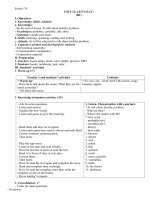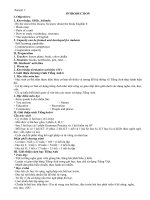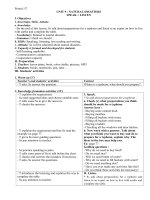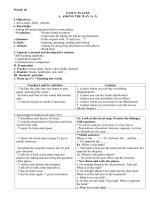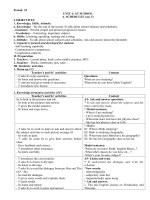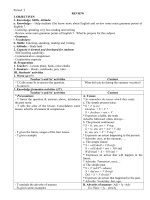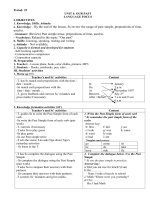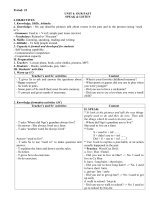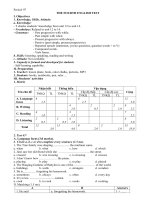unit 2 clothing tiếng anh 9 sách cũ nguyễn văn liệt thư viện giáo án điện tử
Bạn đang xem bản rút gọn của tài liệu. Xem và tải ngay bản đầy đủ của tài liệu tại đây (118.73 KB, 5 trang )
<span class='text_page_counter'>(1)</span><div class='page_container' data-page=1>
<b>Period: 11</b>
<b>UNIT 2: CLOTHING</b>
<b>WRITE</b>
<b>I. OBJECTIVES </b>
<i><b>1. Knowledge, Skills, Attitude: </b></i>
<i><b>a. Knowledge: Ss will be able to write an exposition.</b></i>
<i><b>- Grammar: Present simple tense.</b></i>
I think, Firstly, Secondly,…, Finally, Therefore.
<i><b>- Vocabulary: Related to “Clothing”.</b></i>
<b>b. Skills: Listening, speaking, reading and writing.</b>
<b>c. Attitude: - Ss will be educated about what they should wear when they go</b>
<i><b>2. Capacity is formed and developed for students</b></i>
- Self-learning capability.
- Communicative competence
- Cooperation capacity
<b>II. Preparation</b>
<i><b>1. Teacher: - Lesson plane, book, color chalks, pictures, MP3</b></i>
<i><b>2. Students: - Books, notebooks, pen, ruler …</b></i>
<b>III. Students’ activities</b>
<i><b>1. Warm up (5’)</b></i>
<b>Teacher’s and Ss’ activities</b> <b>Content</b>
- T asks, Ss answer the questions.
- T corrects and gives marks if necessary.
- What do you think about our school uniform?
- Is it convenient?
<i><b>2. Knowledge formation activities (34’)</b></i>
<b>Teacher’s and Ss’ activities</b> <b>Content</b>
- T explains the way to write an argument and new
words.
<i>This is how to present one side of an argument. It is</i>
<i>used to persuade readers to believe or do something.</i>
<i>An argument should have : (table on page 18)</i>
- Ss listen to teacher’s explanation and take notes.
<b>6. Write:</b>
<i>- Ss will be able to write an exposition.</i>
<b>New words :</b>
- point of view (n)
- argument (n)
- sum up (v)
- Ss read the topic and the outline A.
- T explains new words.
- T calls some Ss to read the modal argument before
the class.
<i><b>a. Read the topic and the Outline A. Then read</b></i>
<i><b>the passage.</b></i>
<i><b>* New words :</b></i>
- encourage (v)
- be proud of (v)
- bear one’s name (v)
- equal (adj)
- practical (adj)
- label (n)
- T calls some Ss to read the outline B before the
class.
- Ss write an argument basing on the outline.
- Ss compare their writing in pairs.
<i><b>b. Now write an arguementive paragraph of </b></i>
<i><b>100-150 words. But this time you support the </b></i>
<i><b>argument that secondary school students </b></i>
<i><b>should wear casual clothes. Outline B may </b></i>
<i><b>help you.</b></i>
- Some Ss read their writing before the class.
- T checks and corrects the mistakes if necessary.
<i><b>Suggested answer:</b></i>
<i>My opinion is that secondary school children</i>
<i>should wear casual clothes.</i>
<i>Firstly, casual clothes make students feel</i>
<i>comfortable.</i>
</div>
<span class='text_page_counter'>(2)</span><div class='page_container' data-page=2>
<i>colorful and lively.</i>
<i>In conclusion, secondary school students should</i>
<i>wear casual clothes. Wearing casual clothes is</i>
<i>convenient, comfortable and fun.</i>
<i><b>3. Consolidation (4’)</b></i>
T emphasizes the way to write an argumentative paragraph, Ss pay attention to teacher.
<i><b>4. Its operations (4’)</b></i>
- T asks, Ss answer the questions. Do you want to wear casual clothes or school uniform? Why?
<b>IV. Experience:</b>
………
………
………
<b>Period:</b> <b>12</b>
<b>UNIT 2: CLOTHING</b>
<b>LANGUAGE FOCUS</b>
<b>I. OBJECTIVES </b>
<i><b>1. Knowledge, Skills, Attitude: </b></i>
<i><b>a. Knowledge: - Ss write passive sentences as well as ask and answer yes/no questions using the</b></i>
present perfect tense.
<i><b>- Grammar:</b></i> - The passive
- The present perfect tense
<i><b>- Vocabulary: Related to clothing.</b></i>
<b>b. Skills: Listening, speaking, reading and writing.</b>
<b>c. Attitude: - Not available.</b>
<i><b>2. Capacity is formed and developed for students</b></i>
- Self-learning capability.
- Communicative competence
- Cooperation capacity
<b>II. Preparation</b>
<i><b>1. Teacher: - Lesson plane, book, color chalks, pictures, MP3</b></i>
<i><b>2. Students: - Books, notebooks, pen, ruler …</b></i>
<b>III. Students’ activities</b>
<i><b>1. Warm up (5’)</b></i>
<b>Teacher’s and Ss’ activities</b> <b>Content</b>
- T asks, Ss answer the questions.
- T corrects and gives marks if necessary.
Have you ever gone to Ho Chi Minh city?
<i><b>2. Knowledge formation activities (36’)</b></i>
<b>Teacher’s and Ss’ activities</b> <b>Content</b>
- Ss read the dialogue. Then make new ones.
- T corrects if necessary.
<i><b>1. Work with a partner. Read the dialogue.</b></i>
<i>* Ss read the dialogue clearly and make similar </i>
<i>dialogues</i>
b,c done the same as a.
- T suggestion and has ss practice.
- Ss ask and answer the questions
- T corrects if necessary.
<i><b>2. Work with a partner. Imagine you and your </b></i>
<i><b>partner are visiting HCM city. Ask and answer </b></i>
<i><b>questions about the things you have done. Use </b></i>
<i><b>the present perfect tense of the verbs in the </b></i>
<i><b>box.</b></i>
<i>* Ss use the words given to ask and answer</i>
</div>
<span class='text_page_counter'>(3)</span><div class='page_container' data-page=3>
Yes, I’ve already seen it.
Have you eaten Vietnamese food yet?
No, I haven’t.
- T explains the requirement of the exercises.
- Ss read the example in pairs.
- T explains the way to make questions and answers.
- T helps Ss read and remember the meanings of
suggested words.
- Ss practice asking and answering in pairs.
- T calls some pairs to ask and answer before the
class.
- T checks and corrects student’s mistakes if
necessary.
<i>3<b>. Work with a partner. Ask and answer </b></i>
<i><b>questions about each of the items in the box.</b></i>
<i>* Ss use the words given to ask and answer</i>
<b>Ex:</b>
-Have you ever read a comic ?
Yes, I have.
-When did you last read one ?
This morning.
-Have you ever been to Singapore ?
No, I haven’t.
- T explains the requirement and the example.
- Ss pay attention to teacher.
- T helps Ss remember the way to change the active
sentences into the passive sentences.
- Ss remember and take notes.
- Ss do the exercises individually, and then compare
the answers in pairs.
- Some Ss write the answers on the board.
- T checks and corrects student’s mistakes if
necessary.
- Ss copy down the correct answers.
<i><b>4. Read the sentences and then complete the </b></i>
<i><b>second sentence with the same meaning. Use </b></i>
<i><b>the passive form.</b></i>
<i>* Ss use the passive form</i>
<b>Ex:</b>
They sell jeans all over the world.
<i><b>Jeans are sold all over the world.</b></i>
<i>a. The present tense</i>
S + V + O ….
<i>S + be+ V3/-ed … by O.</i>
<i>b. The perfect tense</i>
S + have/has/had + V3/-ed + O … .
<i>S + have/has/had + been +V3/-ed … by O.</i>
<i>c. Modal verbs</i>
S + modal verb + V + O … .
<i>S + modal verb + be + V3/-ed … by O.</i>
<b>Answer keys :</b>
<i>a. Jean cloth was made completely from cotton </i>
<i>in the 18th<sub> century.</sub></i>
<i>b. Rice is grown in tropical country.</i>
<i>c. Five million bottles of champagne will be</i>
<i>produced in France next year.</i>
<i>d. A new style of jeans has just been introduced</i>
<i>in the USA.</i>
<i>e. Two department stores have been built in this</i>
<i>year.</i>
- T explains the requirement and the example.
Ss do the exercises individually, and then compare
the answers in pairs.
- Some Ss write the answers on the board.
- T checks and corrects student’s mistakes if
necessary.
- Ss copy down the correct answers.
<i><b>5. Change the sentences from the active into </b></i>
<i><b>the passive.</b></i>
<i>* Ss use the passive form with modal verbs.</i>
<b>Ex :</b>
You must do this exercise carefully.
<i><b>This exercise must be done carefully.</b></i>
<b>Answer keys :</b>
<i>a. The problem can be solved.</i>
<i>b. Experiments on animals should be stopped.</i>
<i>c. Life might be found on another planet.</i>
<i>d. All the schools in the city have to be </i>
<i>improved.</i>
<i>e. A new bridge is going to be built in this area.</i>
</div>
<span class='text_page_counter'>(4)</span><div class='page_container' data-page=4>
- T emphasizes the way to make yes/no questions with the present perfect tense, using “ever” as
well as the way to change the active sentences into the passive sentences.
- Ss make more examples.
<b>IV. Experience:</b>
………
………
………
Signature
</div>
<span class='text_page_counter'>(5)</span><div class='page_container' data-page=5></div>
<!--links-->
